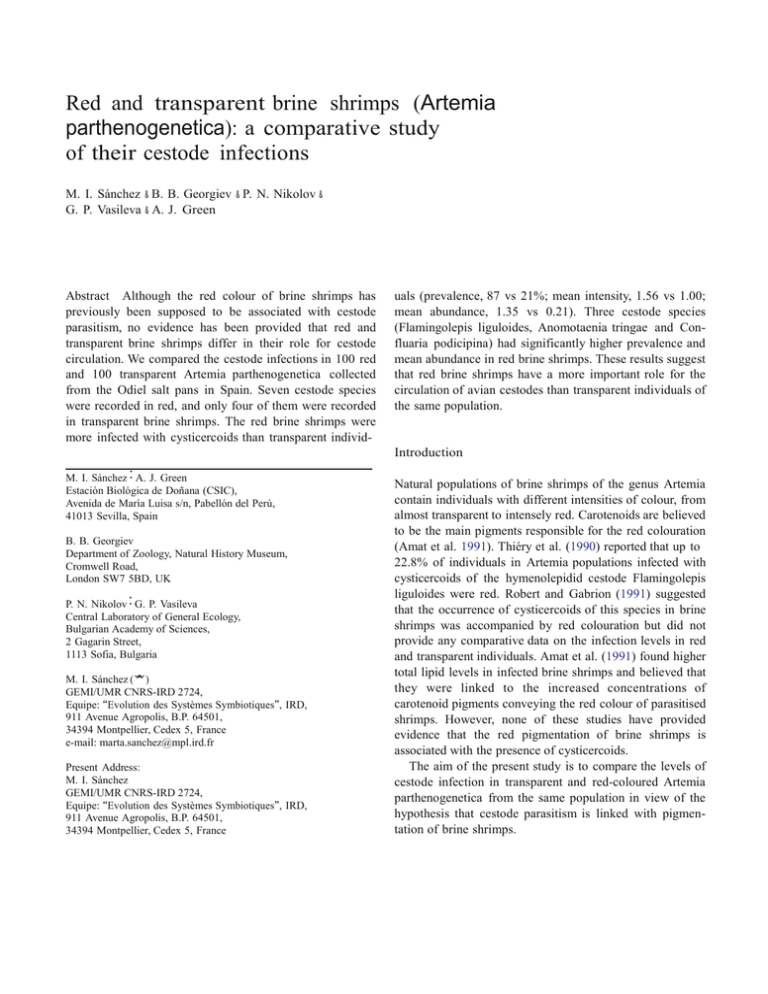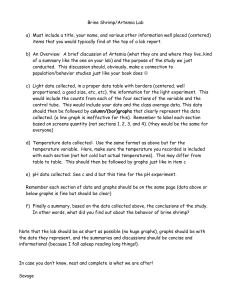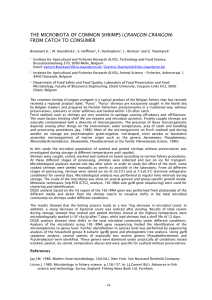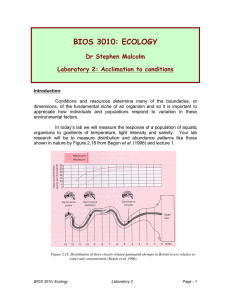parasitolres06.doc
advertisement

Red and transparent brine shrimps (Artemia parthenogenetica): a comparative study of their cestode infections M. I. Sánchez & B. B. Georgiev & P. N. Nikolov & G. P. Vasileva & A. J. Green Abstract Although the red colour of brine shrimps has previously been supposed to be associated with cestode parasitism, no evidence has been provided that red and transparent brine shrimps differ in their role for cestode circulation. We compared the cestode infections in 100 red and 100 transparent Artemia parthenogenetica collected from the Odiel salt pans in Spain. Seven cestode species were recorded in red, and only four of them were recorded in transparent brine shrimps. The red brine shrimps were more infected with cysticercoids than transparent individ- uals (prevalence, 87 vs 21%; mean intensity, 1.56 vs 1.00; mean abundance, 1.35 vs 0.21). Three cestode species (Flamingolepis liguloides, Anomotaenia tringae and Confluaria podicipina) had significantly higher prevalence and mean abundance in red brine shrimps. These results suggest that red brine shrimps have a more important role for the circulation of avian cestodes than transparent individuals of the same population. Introduction M. I. Sánchez : A. J. Green Estación Biológica de Doñana (CSIC), Avenida de María Luisa s/n, Pabellón del Perú, 41013 Sevilla, Spain B. B. Georgiev Department of Zoology, Natural History Museum, Cromwell Road, London SW7 5BD, UK P. N. Nikolov : G. P. Vasileva Central Laboratory of General Ecology, Bulgarian Academy of Sciences, 2 Gagarin Street, 1113 Sofia, Bulgaria M. I. Sánchez (*) GEMI/UMR CNRS-IRD 2724, Equipe: “Evolution des Systèmes Symbiotiques”, IRD, 911 Avenue Agropolis, B.P. 64501, 34394 Montpellier, Cedex 5, France e-mail: marta.sanchez@mpl.ird.fr Present Address: M. I. Sánchez GEMI/UMR CNRS-IRD 2724, Equipe: “Evolution des Systèmes Symbiotiques”, IRD, 911 Avenue Agropolis, B.P. 64501, 34394 Montpellier, Cedex 5, France Natural populations of brine shrimps of the genus Artemia contain individuals with different intensities of colour, from almost transparent to intensely red. Carotenoids are believed to be the main pigments responsible for the red colouration (Amat et al. 1991). Thiéry et al. (1990) reported that up to 22.8% of individuals in Artemia populations infected with cysticercoids of the hymenolepidid cestode Flamingolepis liguloides were red. Robert and Gabrion (1991) suggested that the occurrence of cysticercoids of this species in brine shrimps was accompanied by red colouration but did not provide any comparative data on the infection levels in red and transparent individuals. Amat et al. (1991) found higher total lipid levels in infected brine shrimps and believed that they were linked to the increased concentrations of carotenoid pigments conveying the red colour of parasitised shrimps. However, none of these studies have provided evidence that the red pigmentation of brine shrimps is associated with the presence of cysticercoids. The aim of the present study is to compare the levels of cestode infection in transparent and red-coloured Artemia parthenogenetica from the same population in view of the hypothesis that cestode parasitism is linked with pigmentation of brine shrimps. Materials and methods A sample of A. parthenogenetica was collected on 25 September 2002 from an evaporation pond within the salt pans at the Odiel Marshes (Huelva Province, Spain, 37°17′ N, 06°55′W). Artemia parthenogenetica is the dominant invertebrate in the evaporation ponds, where it is a major prey for waders, gulls, flamingos and grebes (Sánchez et al. 2006). We used a 0.1-mm mesh net for collecting the sample. In the laboratory, we selected two sets of adult specimens consisting of 100 red and 100 transparent individuals, respectively. They were heated to 80°C to kill the cysticercoids and then preserved in 70% ethanol. Subsequently, each shrimp was mounted in a temporary glycerol mount and examined under a microscope. If the identification of the cysticercoids recorded was not possible at this stage, whole brine shrimps or isolated cysticercoids were prepared as permanent mounts in Berlese’s medium to facilitate observations of the rostellar hooks. Descriptions of cysticercoids from our study site are presented by Georgiev et al. (2005). The numbers of cysticercoids, prevalence, mean abundance and mean intensity (see Bush et al. 1997 for definitions) were calculated for all metacestodes and for each species. We compared the cestode prevalence between red and transparent brine shrimps with Z tests. The differences between mean abundance and mean intensity between the two sets were analysed with Mann–Whitney U tests using Statistica 5.5 (StatSoft 1999). We also used Z tests to compare the frequency of red colour between nonparasitised individuals and specimens parasitised with only one cestode species. We performed this latter analysis only for the species appearing as a lone parasite species in at least five host specimens (F. liguloides, A. tringae, C. podicipina and Eurycestus avoceti). P values were always Bonferroni-corrected to avoid type I errors (Holm 1979). Results Seven species of cestodes belonging to three families were identified in the brine shrimps studied (Table 1). Of the 156 cysticercoids found, 39.7% were Confluaria podicipina (a parasite of grebes), 33.3% were Anomotaenia tringae (a parasite of waders), 12.2% were F. liguloides (a parasite of flamingos) and 9.6% were E. avoceti (a parasite of waders). The remaining species combined, that is, Wardium stellorae (a parasite of gulls), Gynandrotaenia stammeri and Flamingolepis flamingo (the latter two are parasites of flamingos), represented less than 5% of the total number of cysticercoids recorded. The prevalence of cysticercoids was significantly higher in red (87%) than in transparent (21%) brine shrimps (Table 1). We did not find C. podicipina, G. stammeri and F. flamingo in transparent brine shrimps. The transparent Artemia, if infected, contained only one cysticercoid per host. The maximum intensity in red individuals was 5. The mean intensity and the mean abundance of cysticercoids were significantly higher in red shrimps (Table 1). The prevalence and the mean abundance of F. liguloides, A. tringae and C. podicipina were significantly higher in red than in transparent shrimps (Table 1). However, we did not find statistically significant differences in the mean intensity for any cestode species. The proportion of infected shrimps containing cysticercoids of only one species (recorded in more than five host specimens) that was red was 66% for F. liguloides (n=6), 55% for A. tringae (n=27), 100% for C. podicipina (n=30) and 50% for E. avoceti (n=8). In contrast, only 14% (n=92) of the unparasitised Artemia were red. There were statistically significant differences in the proportion of red Artemia between uninfected shrimps and those infected only with F. liguloides (z=2.736, p< 0.05), A. tringae (z=3.854, p<0.01) or C. podicipina (z=8.329, p<0.01) after Bonferroni correction. The proportion of red individuals for shrimps only infected with E. avoceti compared with noninfected Artemia was also significantly higher before Bonferroni correction (z=2.100, p=0.03). Discussion Cestodes of 15 species of three families of the order Cyclophyllidea utilise crustaceans of the genus Artemia as intermediate hosts in their two-host life cycles; they all use aquatic birds as final hosts (for a review, see Georgiev et al. 2005). The red colour of brine shrimps is believed to be a result of accumulation of carotenoids (Amat et al. 1991). Artemia individuals contain high concentrations of carotenoids, particularly under hyperhaline conditions, where algae provide the major food source (Abatzopoulos et al. 2002). Some carotenoids (cis-canthaxanthins) have been shown to have specific functions in egg formation and are located in the female reproductive system only, whereas β-carotene, its metabolic precursors and xanthophylls occur in the gut as a result of the algal diet. Others (all-trans-canthaxanthins) are non-specifically distributed throughout the entire body and are believed to have a photoprotective function (Nelis et al. 1984; 1988). In addition, carotenoids form part of the total lipid content and therefore serve as a source of metabolic energy and contribute to the buoyancy of brine shrimps (Amat et al. 1991). Based on several criteria (number of cestode species recorded, prevalence, abundance and intensity), the results of our study suggest that red brine shrimps have a more important role for parasite transmission to final hosts than Table 1 Numbers of cysticercoids, P%, MI, and MA in red and transparent brine shrimps Species Descriptors Red Transparent Total NC P% MI MA NC P% MI MA NC P% MI MA NC P% MI MA NC P% MI MA NC P% MI MA NC P% MI MA NC P% MI MA 135 87 1.56 1.35 17 15 1.13 0.17 39 39 1.00 0.39 62 55 1.13 0.62 11 10 1.10 0.11 3 3 1.00 0.03 2 2 1.00 0.02 1 1 1.00 0.01 21 21 1.00 0.21 2 2 1.00 0.02 13 13 1.00 0.13 0 0 – 0 4 4 1.00 0.04 2 2 1.00 0.02 0 0 – 0 0 0 – 0 Flamingolepis liguloides (Hymenolepididae) Anomotaenia tringae (Dilepididae) Confluaria podicipina (Hymenolepididae) Eurycestus avoceti (Dilepididae) Wardium stellorae (Hymenolepididae) Differences in P% were tested using Z tests; comparisons of MI and MA were made using Mann–Whitney U tests. Only statistically significant values of Z and U are shown NC Numbers of cysticercoids; P% prevalence; MI mean intensity; MA mean abundance *P<0.05; **P<0.01 (after Bonferroni correction) Gynandrotaenia stammeri (Progynotaeniidae) Flamingolepis flamingo (Hymenolepididae) do transparent individuals of the same population. On the basis of the data available, no unequivocal hypothesis about the link between metacestode infection and red colouration can be given. However, some speculative explanations may be proposed. One possible explanation is associated with the hypothesis that metacestodes modify brine shrimp colour to favour transmission to avian predators that act as final hosts (Robert and Gabrion 1991). Making the upstream host more visible to the predator is recognised as one of the major mechanisms facilitating parasite transmission along food chains (see Combes 2001; Moore 2002 for review). Likewise, high lipid content increases the profitability and attractiveness of prey for the final host. Waders prefer red to transparent brine shrimps in captive experiments (M.I. Sánchez, F. Hortas, J. Figuerola and A.J. Green, unpublished data). Adaptive manipulation of energy reserves of the host has been suggested in Gammarus pulex–Pomphorhynchus laevis system (Plaistow et al. 2001). Increased carotenoids and lipid reserves in infected Artemia (Amat et al. 1991) may also function as a parasite strategy to increase Z U 9.22** 535.5* 1,322* 3.04** 4,349* 4.03** 3,750* 8.55** 2,250* the longevity of infected individuals and, thus, to enhance the probability of transmission. In the host–parasite system studied by us, an indirect effect (Thomas et al. 2005) of the cestodes on the colour of the intermediate host seems likely. Infected brine shrimps exhibit positive phototaxis (Sánchez et al. 2006, unpublished data), which is a change from their normal photophobic behaviour (Bradley and Fordward 1984). Thus, infected brine shrimps are likely to spend more time near the water surface, which requires an accumulation of photoprotective pigments. Accumulation of carotenoids (and associated red colouration) has been reported for copepods in lakes exposed to higher UV radiation (Hairston 1979). Alterations in the photophobic behaviour of invertebrate intermediate hosts were demonstrated in several host–parasite systems (Bethel and Holmes 1973; Helluy 1983; Thomas et al. 1996; Bakker et al. 1997), including for cestodes (Hurd and Fogo 1991). Therefore, the increased proportion of red-coloured specimens in the brine shrimp population can be an indirect consequence of cestode infection, mediated by the parasiteinduced positive phototaxis of infected brine shrimps. However, we found that 13% of red brine shrimps were uninfected, and therefore, cestodes cannot be the only cause for their pigmentation. This provokes another speculative explanation for the higher level of cestode infection in the red brine shrimps. The levels of all-trans-canthaxanthins have been shown to increase gradually with the age of Artemia specimens (Nelis et al. 1988). Likewise, cestode infection is also accumulative because our previous studies demonstrated that 19.3% of infected brine shrimps had multiple infections with two to five cestode species (Georgiev et al. 2005). Therefore, an existing infection does not prevent a subsequent infestation of the host individual. Subsequently, older brine shrimps, which have spent more time in the pond, may have accumulated more cysticercoids and simultaneously reached higher concentrations of carotenoids. In addition, because of the photoprotective function of the carotenoids (Nelis et al. 1984, 1988; Amat et al. 1991), pigmented brine shrimps would be able to spend a longer time near the surface of the pond, which is richer in phytoplankton. The hyperhaline pond water (up to 118 gl−1 in our case) is a kind of ‘natural Fulleborn solution’, making cestode eggs float to the surface. Robert and Gabrion (1991) described live eggs of three of the species found in the present study (F. liguloides, W. stellorae and G. stammeri); they all had floating adaptations such as outgrowths of the outer coat or polar filaments. Therefore, the surface water of the ponds can be a much richer source of infective cestode eggs, and pigmented brine shrimps are much likely to be exposed to them than transparent ones. These different speculative explanations are not mutually exclusive. Furthermore, we considered a complex of seven cestode species, and they may have different transmission strategies. Further studies are needed to elucidate cause and effect in the interrelations of carotenoid contents and cestode parasitism. Acknowledgements We are grateful to Professor F. Amat (Instituto de Acuicultura de Torre de la Sal, CSIC, Castellón, Spain) and to Professor F. Palomares (Estación Biológica de Doñana, CSIC, Sevilla, Spain) for stimulating comments and useful suggestions in the course of the present study, and to Dr. D.I. Gibson (Natural History Museum, London) for reading the manuscript. This study was carried out in the framework of a cooperative program between the Bulgarian Academy of Sciences and the Consejo Superior de Investigaciones Cientificas (project 2004BG0013). References Abatzopoulos TJ, Beardmore JA, Clegg JS, Sorgeloos P (2002) Artemia: basic and applied biology. Kluwer, Dordrecht Amat F, Gozalbo A, Navarro JC, Hontoria F, Varó I (1991) Some aspects of Artemia biology affected by cestode parasitism. Hydrobiologia 212:39–44 Bakker TCM, Mazzi D, Zala S (1997) Parasite-induced changes in behavior and color make Gammarus pulex more prone to fish predation. Ecology 78:1098–1104 Bethel WM, Holmes JC (1973) Altered evasive behavior and responses to light in amphipods harboring acanthocephalan cystacanths. J Parasitol 59:945–956 Bradley DJ, Fordward RB (1984) Phototaxis of adult brine shrimp Artemia salina. Can J Zool 62:2357–2359 Bush AO, Lafferty KD, Lotz JM, Shostak AW (1997) Parasitology meets ecology on its own terms: Margolis et al. revisited. J Parasitol 83:575–583 Combes C (2001) Parasitism. The ecology and evolution of intimate interactions. University of Chicago Press, Chicago Georgiev BB, Sánchez MI, Green AJ, Nikolov PN, Vasileva GP, Mavrodieva RS (2005) Cestodes from Artemia parthenogenetica (Crustacea, Branchiopoda) in the Odiel Marshes, Spain: a systematic survey of cysticercoids. Acta Parasitol 50:105–117 Hairston NG (1979) Adaptive significance of color polymorphism in 2 species of Diaptomus (Copepoda). Limnol Oceanogr 24:15–37 Helluy S (1983) Un mode de favorisation de la transmission parasitaire: la manipulation du comportement de l´hôte intermédiaire. Rev Écol 38:211–223 Holm S (1979) A simple sequentially rejective multiple test procedure. Scand J Statist 6:65–70 Hurd H, Fogo S (1991) Changes induced by Hymenolepis diminuta (Cestoda) in the behaviour of the intermediate host Tenebrio molitor (Coleoptera). Can J Zool 69:2291–2294 Moore J (2002) Parasites and the behaviour of animals. Oxford University Press, Oxford Nelis HJCF, Lavens P, Moens L, Sorgeloos P, Jonckheere JA, Criel GR, De Leenheer AP (1984) cis-Canthaxanthins, unusual carotenoids in the eggs and the reproductive system of female brine shrimps Artemia. J Biol Chem 259:6063–6066 Nelis HJCF, Lavens P, Van Steenberge MMZ, Sorgeloos P, Criel GR, De Leenheer AP (1988) Quantitative and qualitative changes in the carotenoids during development of the brine shrimp Artemia. J Lipid Res 29:491–499 Plaistow SJ, Troussard JP, Cézilly F (2001) The effect of the acanthocephalan parasite Pomphorhynchus laevis on the lipid and glycogen content of its intermediate host Gammarus pulex. Int J Parasitol 31:346–351 Robert F, Gabrion C (1991) Cestodoses de l’avifaune Camarguaise. Rôle d’Artemia (Crustacea, Anostraca) et stratégies de rencontre hôte-parasite. Ann Parasitol Hum Comp 66:226–235 Sánchez MI, Green AJ, Castellanos EM (2006) Temporal and spatial variation of an aquatic invertebrate community subjected to avian predation at the Odiel salt pans (SW Spain). Arch Hydrobiol 166: 199–223 StatSoft (1999) Statistica 5.5. StatSoft, Tulsa Thiéry A, Robert F, Gabrion C (1990) Distribution des populations d’Artemia et de leur parasite Flamingolepis liguloides (Cestoda, Cyclophyllidea), dans les salins du littoral méditerranéen français. Can J Zool 68:2199–2204 Thomas F, Verneau O, Santalla F, Cézilly F, Renaud F (1996) The influence of intensity of infection by a trematode parasite on the reproductive biology of Gammarus insensibilis (Amphipoda). Int J Parasitol 26:1205–1209 Thomas F, Adamo S, Moore J (2005) Parasitic manipulation: where are we and where should we go? Behav Processes 68:185–199




